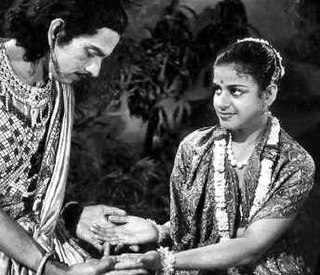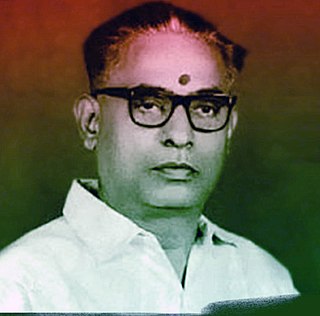Related Research Articles

Carnatic music, known as Karnāṭaka saṃgīta or Karnāṭaka saṅgītam in the South Indian languages, is a system of music commonly associated with South India, including the modern Indian states of Karnataka, Andhra Pradesh, Telangana, Kerala and Tamil Nadu, and Sri Lanka. It is one of two main subgenres of Indian classical music that evolved from ancient Hindu texts and traditions, particularly the Samaveda. The other subgenre being Hindustani music, which emerged as a distinct form because of Persian or Islamic influences from Northern India. The main emphasis in Carnatic music is on vocal music; most compositions are written to be sung, and even when played on instruments, they are meant to be performed in gāyaki (singing) style.

Thyagaraja, also known as Thyāgayya and in full as Kakarla Thyagabrahmam, was a composer and vocalist of Carnatic music, a form of Indian classical music. Tyagaraja and his contemporaries, Shyama Shastri and Muthuswami Dikshitar, are regarded as the Trinity of Carnatic music. Thyagaraja composed thousands of devotional compositions, most in Telugu and in praise of Lord Rama, many of which remain popular today, the most popular being "Nagumomu". Of special mention are five of his compositions called the Pancharatna Kritis, which are often sung in programs in his honour, and Utsava Sampradaya Krithis, which are often sung to accompany temple rituals.

Mangalampalli Balamuralikrishna was an Indian Carnatic vocalist, musician, multi-instrumentalist, playback singer, composer, and character actor. He was awarded the Madras Music Academy's Sangeetha Kalanidhi in 1978. He has garnered two National Film Awards, the Sangeet Natak Akademi Award in 1975, the Padma Vibhushan, India's second-highest civilian honor in 1991, for his contribution towards arts, the Mahatma Gandhi Silver Medal from UNESCO in 1995, the Chevalier of the Ordre des Arts et des Lettres by the French Government in 2005, the Sangeetha Kalanidhi by Madras Music Academy, and the Sangeetha Kalasikhamani in 1991, by the Fine Arts Society, Chennai to name a few.

Muthuswami Dikshitar (Mudduswamy Dikshitar)(IAST: muttusvāmi dīkṣitar, 24 March 1776 – 21 October 1835), mononymously Dikshitar, was a South Indian poet, singer and veena player, and a legendary composer of Indian classical music, who is considered one of the musical trinity of Carnatic music. Muthuswami Dikshitar was born on 24 March 1775 in Tiruvarur near Thanjavur, in what is now the state of Tamil Nadu in India, to a family that is traditionally traced back to Virinichipuram in the northern boundaries of the state. His compositions, of which around 500 are commonly known, are noted for their elaborate and poetic descriptions of Hindu gods and temples and for capturing the essence of the raga forms through the vainika (veena) style that emphasises gamakas. They are typically in a slower speed (chowka kala). He is also known by his signature name of Guruguha which is also his mudra (and can be found in each of his songs). His compositions are widely sung and played in classical concerts of Carnatic music.

Shyama Shastri( Telugu : శ్యామ శాస్త్రి) or Syama Sastri was a musician and composer of Carnatic music. He was the oldest among the Trinity of Carnatic music, Tyagaraja and Muthuswami Dikshitar being the other two.

Gudalur Narayanaswamy Balasubramaniam, popularly known as GNB, was an Indian Carnatic singer. He innovated the art through emphasis on laya control and reducing the gamakas which eventually made Carnatic music appeal to the lay and the learned alike. He was also a Tamil film actor.Ariyakudi Iyengar inspired him.

Tyagaraja Aradhana is an annual aradhana of Telugu saint composer Tyagaraja. The music festival is observed in the states of Andhra Pradesh, Karnataka and Tamil Nadu, primarily in Tiruvaiyaru in Thanjavur district of Tamilnadu, the place where Tyagaraja attained Jeeva Samadhi.The aradhana is observed on Pushya Bahula Panchami day when the saint attained Jeeva samadhi, where the musicians render the saint's Pancharatna Kritis.

Lalgudi Gopala Jayaraman was an Indian Carnatic violinist, vocalist and composer. He is commonly grouped with M.S. Gopalakrishnan and T.N.Krishnan as part of the violin-trinity of Carnatic Music. He was awarded Padma Bhushan by the Government of India in 2001.

Anandabhairavi or Ananda Bhairavi is a very old melodious rāgam of Carnatic music. This rāgam also used in Indian traditional and regional musics. Ānandam (Sanskrit) means happiness and the rāgam brings a happy mood to the listener.
Dr. Jon Borthwick Higgins, also known in India as Higgins Bhagavatar, was an American musician, scholar, and teacher known principally for his rare skill as a non-Indian in the field of Carnatic music.

Narasimhan Ravikiran is an Indian slide instrumentalist, vocalist, composer, and orator, who created the concept of melharmony. He is the son of gottuvadhyam player Chitravina Narasimhan and the grandson of Narayan Iyengar, who was also a Carnatic musician.
Trichy Sankaran is an Indian percussionist, composer, scholar, and educator. He was awarded the Madras Music Academy's Sangeetha Kalanidhi in 2011. As a mridangam vidwan, he has been called a "doyen among the percussionists of India" in Sruti magazine. Since the early 1970s, he has performed and recorded in a number of cross-cultural projects. In 2017, he was awarded the "Tiruchirapalli Carnatic Musicians Lifetime Achievement Award".

Musiri Subramania Iyer was a Carnatic vocalist whose stage performing career spanned the 1920s to the 1940s. After retirement from the stage, he remained an iconic figure in Carnatic music as a dedicated teacher and leader in the Carnatic community. His bhava-laden renditions of Carnatic songs have become the measuring stick for generations of Carnatic vocalists. Musiri Subramania Iyer is considered one of the giants of Carnatic music in the twentieth century.

“Kalaimamani” Gayathri Girish is a Carnatic vocalist. Her introduction to music began as a child at the age of 6 years under the guidance of her mother Padmini Srinivasan. She subsequently came under the tutelage of Vidwan Vaigal.S.Gnanaskandan and Padma Bhushan, Sangeetha Kalanidhi Madurai T.N.Seshagopalan. She is an “A-grade” artiste of All India Radio, Chennai and performs for Doordarshan and other private television channels. She specialises in lecture-sessions, thematic multi-media presentations integrating Bhakti and Carnatic Music and lecture-demonstrations. She undertook an archival project for Doordarshan - Podhigai TV titled “Azhwargalum Amudha Tamizhum” to render the Azhwar Pasurams on DD Podhigai television every week for 8 consecutive years. She also serves on the artist panel for the ICCR which is an autonomous organisation of the Government of India, involved in India's external cultural relations, through cultural exchange with other countries and their peoples.
Radha Viswanathan was an Indian vocalist and classical dancer. She performed extensively with her mother, Bharat Ratna Carnatic vocalist M. S. Subbulakshmi.

Bangalore Nagarathnamma was an Indian carnatic singer, cultural activist, scholar, and courtesan. A descendant of courtesans, she was also a patron of the arts and a historian. Nagarathnamma built a temple over the samadhi of the Carnatic singer Tyagaraja at Thiruvaiyaru and helped establish the Tyagaraja Aradhana festival in his memory. Within a male dominated festival, she was the feminist aggressive enough to ensure that women artists were given equality to participate in it. She "was among the last practitioners of the devadasi tradition in India," and the first president of the Association of the Devadasis of Madras Presidency. She also edited and published books on poetry and anthologies.

B. Rajam Iyer was a Carnatic singer from South India. He was awarded the Madras Music Academy's Sangeetha Kalanidhi in 1987.
Asthana Vidushi is an honorary title bestowed to a court musician or dancer in India. Notable Asthana Vidushis include Bangalore Nagarathnamma, Aruna Sairam, Bombay Sisters, M. S. Sheela, Geetha Raja, as well as Srirangam Gopalaratnam, Shobha Raju, and S. Sowmya.
Hyderabad Tyagaraja Aaradhana Music Festival (HTAMF) is an annual 5 day Carnatic music festival held in Hyderabad, Telangana at Shilparamam. It is held on the lines of the popular Tyagaraja Aradhana by Sanskriti Foundation which was found in 2005 and registered in 2008 by ViloinVasu a violinist, music teacher and researcher.
References
- 1 2 "Cleveland Thyagaraja Festival (photos)". cleveland.com. Retrieved 2017-02-19.
- 1 2 Tuttle, T. Temple (1982). Proceedings of the Saint Thyagaraja Music Festival, Cleveland Ohio, 1978-81. Cleveland, OH: The Greater Cleveland Ethnographic Museum. pp. 6–8.
- ↑ "Ramnad Ragnavan". dpnelson.web.wesleyan.edu. Retrieved 2017-02-19.
- ↑ "Past Contributor: Ramnad Sri V. Raghavan". www.aradhana.org. Retrieved 2017-02-19.
- ↑ "r a v i k i r a n m u s i c . c o m". www.ravikiranmusic.com. Retrieved 2017-02-19.
- 1 2 "SHOWS OF MAXIMUM MEDIA". Maximum Media. Retrieved 2017-02-19.
- ↑ "iCarnatic". icarnatic. Retrieved 2017-02-19.
- ↑ "Kathakali - in the air ... Photo by Prasanna Ranganathan — National Geographic Your Shot". National Geographic Your Shot. Retrieved 2017-02-19.
- ↑ Ganapathy, Lata. "Spotlight on dance at the Cleveland Thyagaraja Festival". The Hindu. Retrieved 2017-02-19.
- ↑ Saranyan, Vidya. "Parable redefined". The Hindu. Retrieved 2017-02-19.
- 1 2 Vijayaraghavan, Sujatha. "Budding talent in bloom". The Hindu. Retrieved 2017-02-19.
- ↑ "Margam — A Dance Workshop at the Cleveland Thyagaraja Festival". www.aradhana.org. Retrieved 2017-02-19.
- ↑ "Kuchipudi dance team floored by response in US". www.thehindu.com. 2010-05-07. Retrieved 2017-02-19.
- ↑ "SVBC". www.svbcttd.com. Retrieved 2017-02-19.